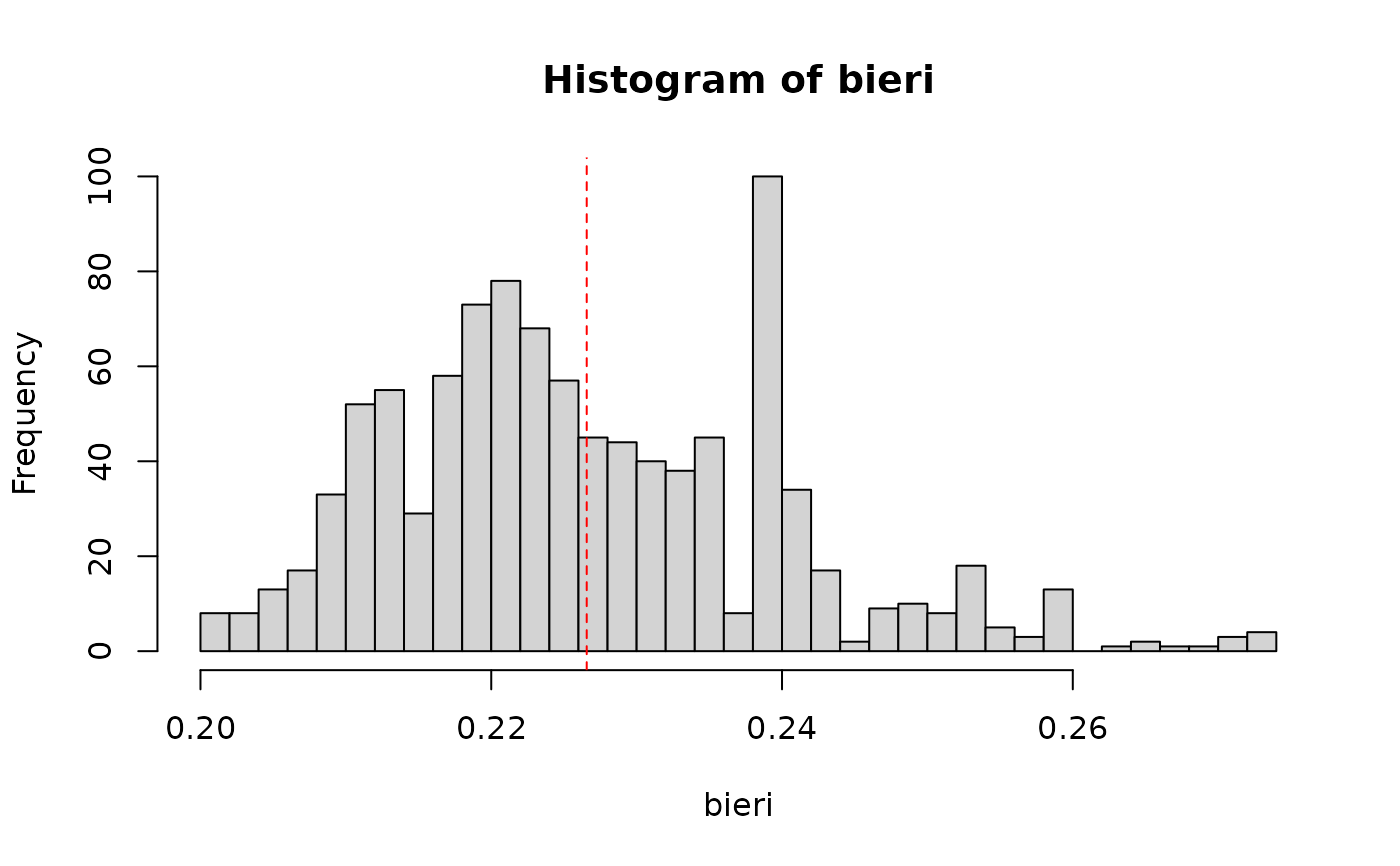The index builds on the number of rating matches between pairs of constructs. It is the relation between the total number of matches and the possible number of matches.
Value
List of class indexBieri:
grid: The grid used to calculate the indexdeviationThe deviation parameter.matches_maxMaximum possible number of matches across constructs.matchesTotal number of matches across constructs.constructs: Matrix with no. of matches for constructs.bieri: Bieri index (= matches / matches_max)
Examples
m <- indexBieri(boeker)
# several output options
print(m)
#>
#> ######################
#> BIERI COMPLEXITY INDEX
#> ######################
#>
#> Bieri: 0.24
#>
#> Maximal rating difference to count as match: 0
#> Total no. of matches between constructs: 327
#> Maximum possible no. of matches between constructs: 1365
print(m, output = "IC") # construct matches
#>
#> ######################
#> BIERI COMPLEXITY INDEX
#> ######################
#>
#> Bieri: 0.24
#>
#> Maximal rating difference to count as match: 0
#> Total no. of matches between constructs: 327
#> Maximum possible no. of matches between constructs: 1365
#>
#> MATCHES BETWEEN CONSTRUCTS
#>
#> 1 2 3 4 5 6 7 8 9 10 11 12
#> 1 balanced - get along with conflicts 1 2 3 2 6 5 4 4 6 1 4 5
#> 2 isolated - sociable 2 3 2 4 3 2 3 2 4 1 5
#> 3 closely integrated - excluded 3 4 3 0 5 5 2 2 5 5
#> 4 discursive - passive 4 6 4 4 4 6 1 3 3
#> 5 open minded - indifferent 5 4 5 4 7 2 4 7
#> 6 dreamy - dispassionate 6 4 6 8 4 2 4
#> 7 practically oriented - depressed 7 3 8 1 5 4
#> 8 playful - serious 8 3 3 2 6
#> 9 socially minded - selfish 9 0 2 6
#> 10 quarrelsome - peaceful 10 3 3
#> 11 artistic - technical 11 3
#> 12 scientific - emotional 12
#> 13 introvert - extrovert 13
#> 14 wanderlust - home oriented 14
#> 13 14
#> 1 4 6
#> 2 6 2
#> 3 4 2
#> 4 3 2
#> 5 4 3
#> 6 2 4
#> 7 2 3
#> 8 8 3
#> 9 2 5
#> 10 3 0
#> 11 0 3
#> 12 4 3
#> 13 3
#> 14
# extract the matrix of matches
m$constructs
#> [,1] [,2] [,3] [,4] [,5] [,6] [,7] [,8] [,9] [,10] [,11] [,12] [,13]
#> [1,] NA 2 3 2 6 5 4 4 6 1 4 5 4
#> [2,] 2 NA 3 2 4 3 2 3 2 4 1 5 6
#> [3,] 3 3 NA 4 3 0 5 5 2 2 5 5 4
#> [4,] 2 2 4 NA 6 4 4 4 6 1 3 3 3
#> [5,] 6 4 3 6 NA 4 5 4 7 2 4 7 4
#> [6,] 5 3 0 4 4 NA 4 6 8 4 2 4 2
#> [7,] 4 2 5 4 5 4 NA 3 8 1 5 4 2
#> [8,] 4 3 5 4 4 6 3 NA 3 3 2 6 8
#> [9,] 6 2 2 6 7 8 8 3 NA 0 2 6 2
#> [10,] 1 4 2 1 2 4 1 3 0 NA 3 3 3
#> [11,] 4 1 5 3 4 2 5 2 2 3 NA 3 0
#> [12,] 5 5 5 3 7 4 4 6 6 3 3 NA 4
#> [13,] 4 6 4 3 4 2 2 8 2 3 0 4 NA
#> [14,] 6 2 2 2 3 4 3 3 5 0 3 3 3
#> [,14]
#> [1,] 6
#> [2,] 2
#> [3,] 2
#> [4,] 2
#> [5,] 3
#> [6,] 4
#> [7,] 3
#> [8,] 3
#> [9,] 5
#> [10,] 0
#> [11,] 3
#> [12,] 3
#> [13,] 3
#> [14,] NA
# CAVEAT: Bieri's index changes when constructs are reversed
nr <- nrow(boeker)
l <- replicate(1000, swapPoles(boeker, sample(nr, sample(nr, 1))))
bieri <- sapply(l, function(x) indexBieri(x)$bieri)
hist(bieri, breaks = 50)
abline(v = mean(bieri), col = "red", lty = 2)

